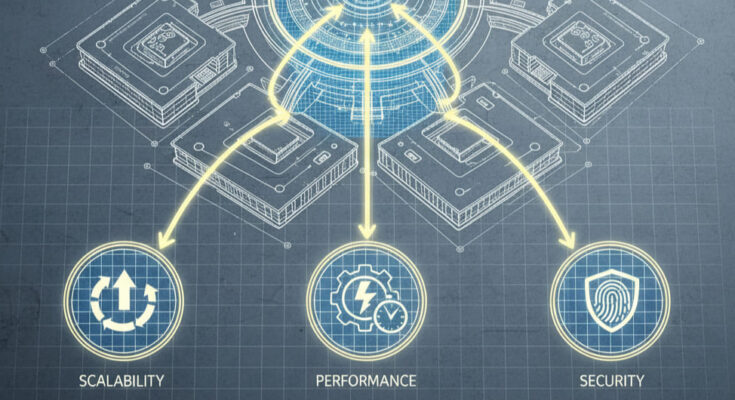Your application is slow. Your servers are overloaded. Your database is a bottleneck. Developers are afraid to make changes. This is a common story. The root cause is almost always a failure to understand why selecting the right architecture is important.
Many teams treat architecture as an afterthought. They rush to build features, creating code that becomes “heavy on server and database.”
This approach saves time today at the cost of your product’s future. A good architecture, in contrast, is the “primary carrier of system qualities”. It is the foundation for performance, scalability, and long-term success.
How Architecture Impacts Server Performance
Your choice of architecture directly dictates your server’s “resource utilization,” including its CPU, memory, and bandwidth. A poor architecture creates “bottlenecks”. A good one manages resources efficiently.
The Monolith vs. Microservices Trade-off
Consider the classic monolith. This is a “single, extensive, executable application”. All its components, like user login, reporting, and payments, are “interdependent”.
This design is simple to start. But it scales poorly. If your reporting module becomes “heavy” and needs more CPU, you must deploy a new, larger copy of the entire application. You cannot scale just one piece.
A microservices architecture solves this. It breaks the app into “small independent components”. If the reporting service is slow, you can “rapidly be deployed” new instances of only that service.
This shows why selecting the right architecture is important. However, microservices add their own “heaviness.” They create “exponential infrastructure costs” and complex “debugging challenges”. The right architecture is not about “microservices is better.” It is about intentionally choosing the right trade-off for your specific business needs.
Protecting Your Database: The Architectural “Firewall”
A “heavy” database is often a symptom of a “chatty” application. Your architecture has failed to create a clean boundary.
The N+1 Query: A Silent Performance Killer
The N+1 query problem is a perfect example of this. It is a “silent performance killer” that often goes “unnoticed” until your database “starts sweating”.
Here is how it happens:
- The “1” Query: Your app makes one query to get 100 blog posts.
- The “N” Queries: It then loops through those 100 posts and makes a new query for each one to get the author’s name.
Your code just made 101 database requests. One developer found this exact problem caused “hundreds of synchronous DB calls, incurring… 10 seconds of wall-time”. This single flaw can “timeout the application”.
Patterns to Reduce Database Load
A good architecture protects the database. It uses patterns to reduce this “heavy” load.
- Caching: A cache-aside pattern stores frequently read data (like a user’s profile) in a fast, in-memory cache like Redis. The application checks the cache first. It only hits the database if the data is missing. This “reduce[s] Load on the Server” and database dramatically.
- Queuing: For heavy write operations (like processing an order), a good architecture uses a queue. The app places the job in a queue and immediately responds to the user. A separate worker process then pulls from the queue, preventing database “concurrency issues”.
The Business Case: Architecture for Growth
Ultimately, why selecting the right architecture is important is a business question. The answer determines your company’s future.
The Pillars of Good Architecture
Good architecture provides two key business benefits: scalability and maintainability.
- Scalability: This is the “capacity to handle increased users, data volume, or transaction volume”. It is how systems like Netflix, Amazon, and Uber grew from simple products into global giants. A “well-designed software architecture ensures that your system can grow seamlessly”.
- Maintainability: A clean architecture uses “Modularity & Loose Coupling”. This means components are independent. You can “update and maintain the system” easily. You can add new features without breaking existing ones.
The Strategic Value
A good architecture “reduces costs” by avoiding “codes duplicity”. It “reduces business and mission risk” by identifying design flaws early.
It enables “agile, iterative development”. It is not a rigid plan set in stone. It is a flexible foundation that allows your team to “reorient quickly” and adapt to new business goals.
Conclusion: Your System’s Foundation
Selecting the right architecture is not an academic exercise. It is the most important technical decision you will make.
It is the difference between a system that collapses under its own weight and one that scales to meet demand. It is the foundation that determines your system’s performance, your developers’ speed, and your business’s ability to grow.




